Magnesium Alloy Matching Layer for High-Performance Transducer Applications
Abstract
:1. Introduction
2. Materials and Methods
2.1. Design of the Transducers
2.2. Transducer Fabrication and Characterization
3. Results and Discussions
4. Conclusions
Author Contributions
Funding
Conflicts of Interest
References
- Chilibon, I. Ultrasound transducer for medical therapy. Sens. Actuators A Phys. 2008, 142, 124–129. [Google Scholar] [CrossRef]
- Ma, T.; Yu, M.; Chen, Z.; Fei, C.; Shung, K.; Zhou, Q. Multi-frequency intravascular ultrasound (IVUS) imaging. IEEE Trans. Ultrason. Ferroelectr. Freq. Control 2015, 62, 97–107. [Google Scholar] [CrossRef] [PubMed] [Green Version]
- Zhou, Q.; Lam, K.H.; Zheng, H.; Qiu, W.; Shung, K.K. Piezoelectric single crystal ultrasonic transducers for biomedical applications. Prog. Mater. Sci. 2014, 66, 87–111. [Google Scholar] [CrossRef] [PubMed] [Green Version]
- Haertling, G.H. Ferroelectric Ceramics: History and Technology. J. Am. Ceram. Soc. 1999, 82, 798–818. [Google Scholar] [CrossRef]
- Hsu, H.S.; Zheng, F.; Li, Y.; Lee, C.; Zhou, Q.; Shung, K.K. Focused high frequency needle transducer for ultrasonic imaging and trapping. Appl. Phys. Lett. 2012, 101. [Google Scholar] [CrossRef] [PubMed]
- Zhang, Z.; Xu, J.; Yang, L.; Liu, S.; Xiao, J.; Li, X.; Wang, X.; Luo, H. Design and comparison of PMN-PT single crystals and PZT ceramics based medical phased array ultrasonic transducer. Sens. Actuators A Phys. 2018, 283, 273–281. [Google Scholar] [CrossRef]
- Park, C.Y.; Sung, J.H.; Jeong, J.S. Design and fabrication of ultrasound linear array transducer based on polarization inversion technique. Sens. Actuators A Phys. 2018, 280, 484–494. [Google Scholar] [CrossRef]
- Desilets, C.S.; Fraser, J.D.; Kino, G.S. The Design of Efficient Broad-Band Piezoelectric Transducers. IEEE Trans. Sonics Ultrason. 1978, 25, 115–125. [Google Scholar] [CrossRef]
- Cabrera-Munoz, N.E.; Eliahoo, P.; Wodnicki, R.; Jung, H.; Chiu, C.T.; Williams, J.A.; Kim, H.H.; Zhou, Q.; Shung, K.K. Forward-looking 30-MHz phased-array transducer for peripheral intravascular imaging. Sens. Actuators A Phys. 2018, 280, 145–163. [Google Scholar] [CrossRef]
- Manh, T.; Nguyen, A.T.T.; Johansen, T.F.; Hoff, L. Microfabrication of stacks of acoustic matching layers for 15 MHz ultrasonic transducers. Ultrasonics 2014, 54, 614–620. [Google Scholar] [CrossRef] [PubMed]
- Fang, H.J.; Chen, Y.; Wong, C.M.; Qiu, W.B.; Chan, H.L.W.; Dai, J.Y.; Li, Q.; Yan, Q.F. Anodic aluminum oxide-epoxy composite acoustic matching layers for ultrasonic transducer application. Ultrasonics 2016, 70, 29–33. [Google Scholar] [CrossRef] [PubMed]
- Zhou, Q.; Cha, J.H.; Huang, Y.; Zhang, R.; Cao, W.; Shung, K.K. Alumina/epoxy nanocomposite matching layers for high-frequency ultrasound transducer application. IEEE Trans. Ultrason. Ferroelectr. Freq. Control 2009, 56, 213–219. [Google Scholar] [CrossRef] [PubMed] [Green Version]
- Guo, F.; Wang, Y.; Huang, Z.; Qiu, W.; Zhang, Z.; Wang, Z.; Dong, J.; Yang, B.; Cao, W. Magnesium Alloy Matching Layer for PMN-PT Single Crystal Transducer Applications. IEEE Trans. Ultrason. Ferroelectr. Freq. Control 2018, 65, 1865–1872. [Google Scholar] [CrossRef] [PubMed]
- Cannata, J.M.; Ritter, T.A.; Chen, W.H.; Silverman, R.H.; Shung, K.K. Design of efficient, broadband single-element (20–80 MHz) ultrasonic transducers for medical imaging applications. IEEE Trans. Ultrason. Ferroelectr. Freq. Control 2003, 50, 1548–1557. [Google Scholar] [CrossRef] [PubMed]
- Safari, A.; Akdoǧan, E.K. Piezoelectric and Acoustic Materials for Transducer Applications; Springer Science & Business Media: New York, NY, USA, 2008; ISBN 9780387765389. [Google Scholar]
- Erikson, K.R.; Banjavic, R.A. Standard methods for testing single-element pulse-echo ultrasonic transducers-AIUM Interim Standard. J. Ultrasound Med. 1981, 1, 1–18. [Google Scholar]
- Li, X.; Ma, T.; Tian, J.; Han, P.; Zhou, Q.; Shung, K.K. Micromachined PIN-PMN-PT crystal composite transducer for high-frequency intravascular ultrasound (IVUS) imaging. IEEE Trans. Ultrason. Ferroelectr. Freq. Control 2014, 61, 1171–1178. [Google Scholar] [CrossRef] [PubMed] [Green Version]
- Ultrasonic Transducers. Available online: http://www.olympus-ims.com/en/ultrasonic-transducers/ (accessed on 20 November 2018).




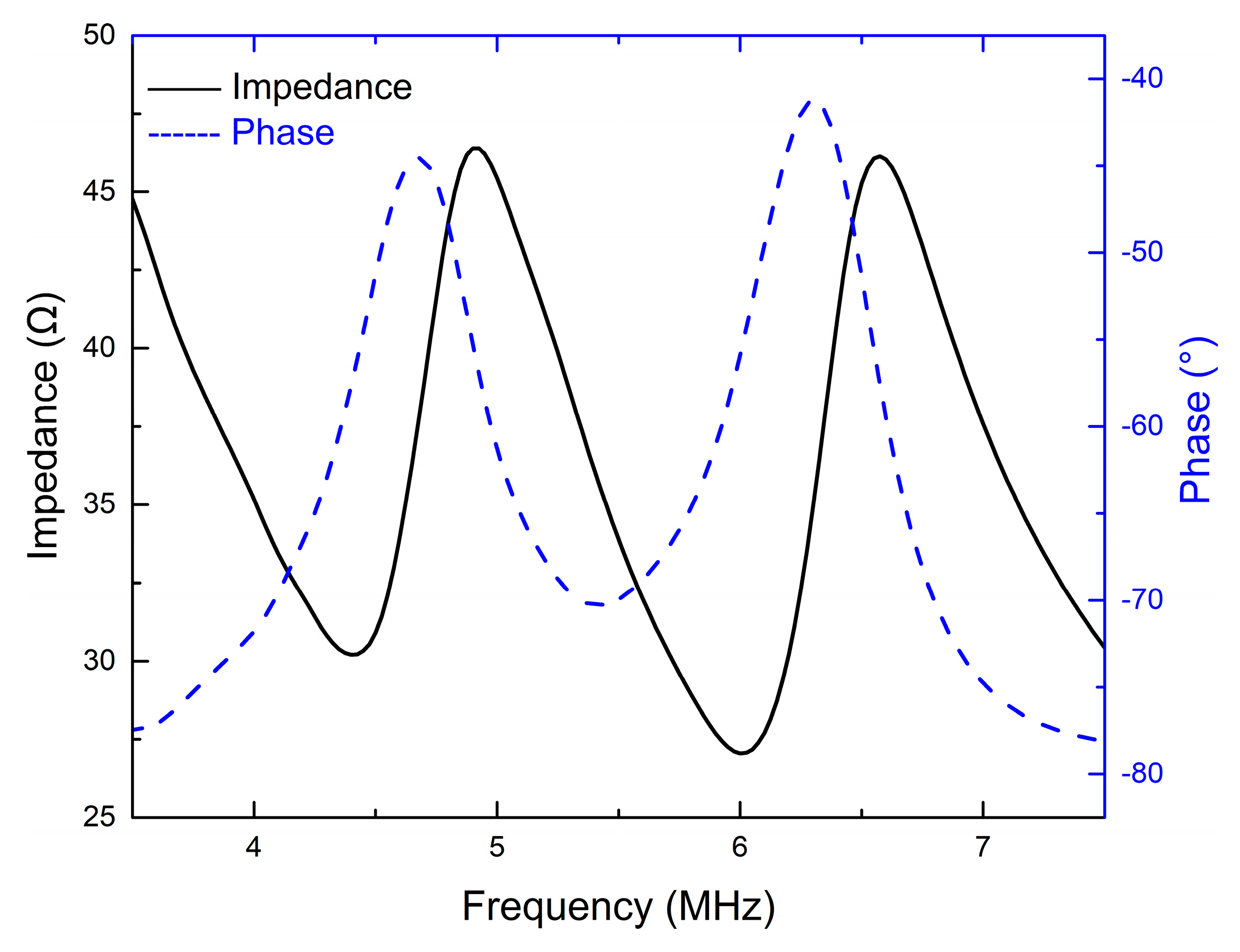
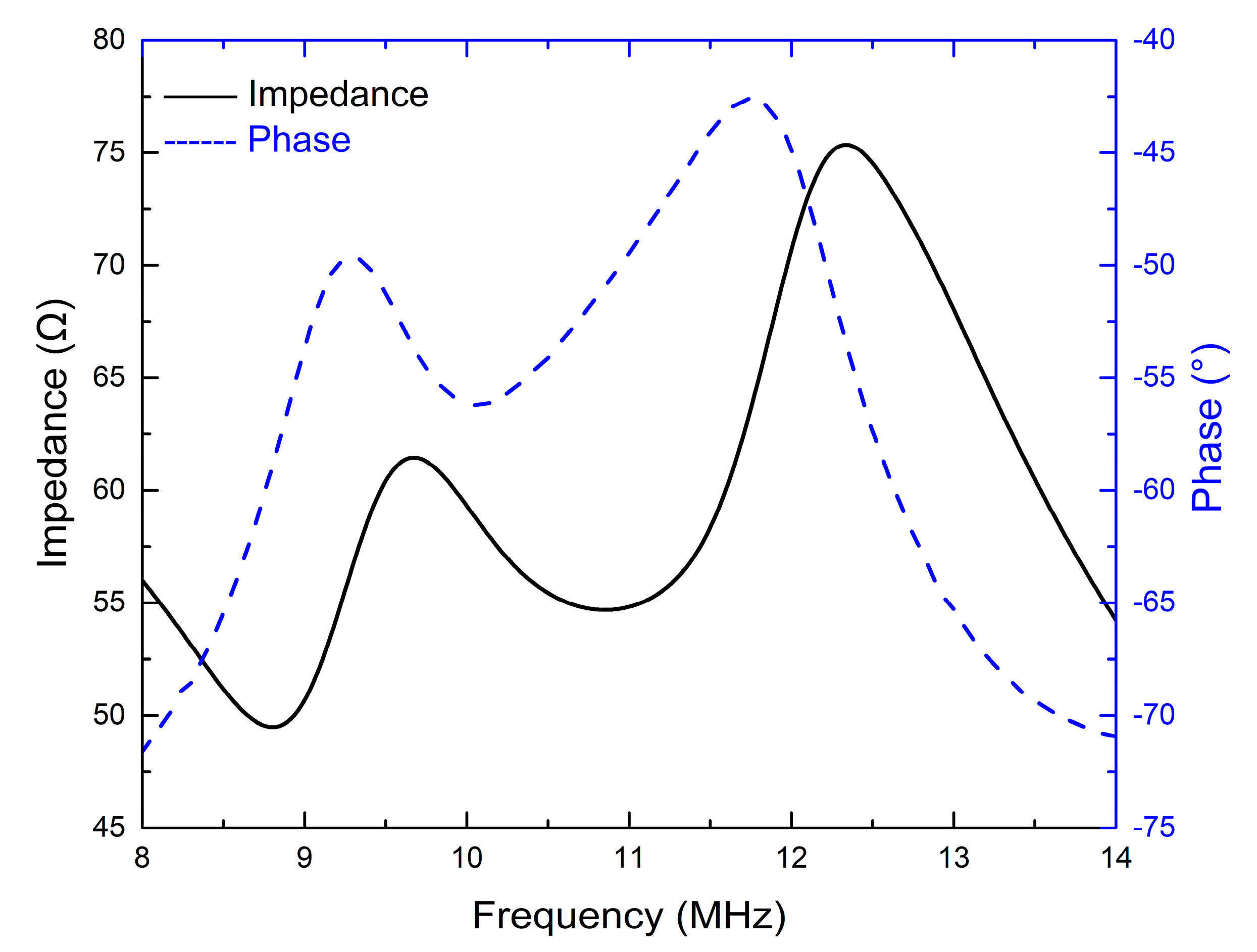
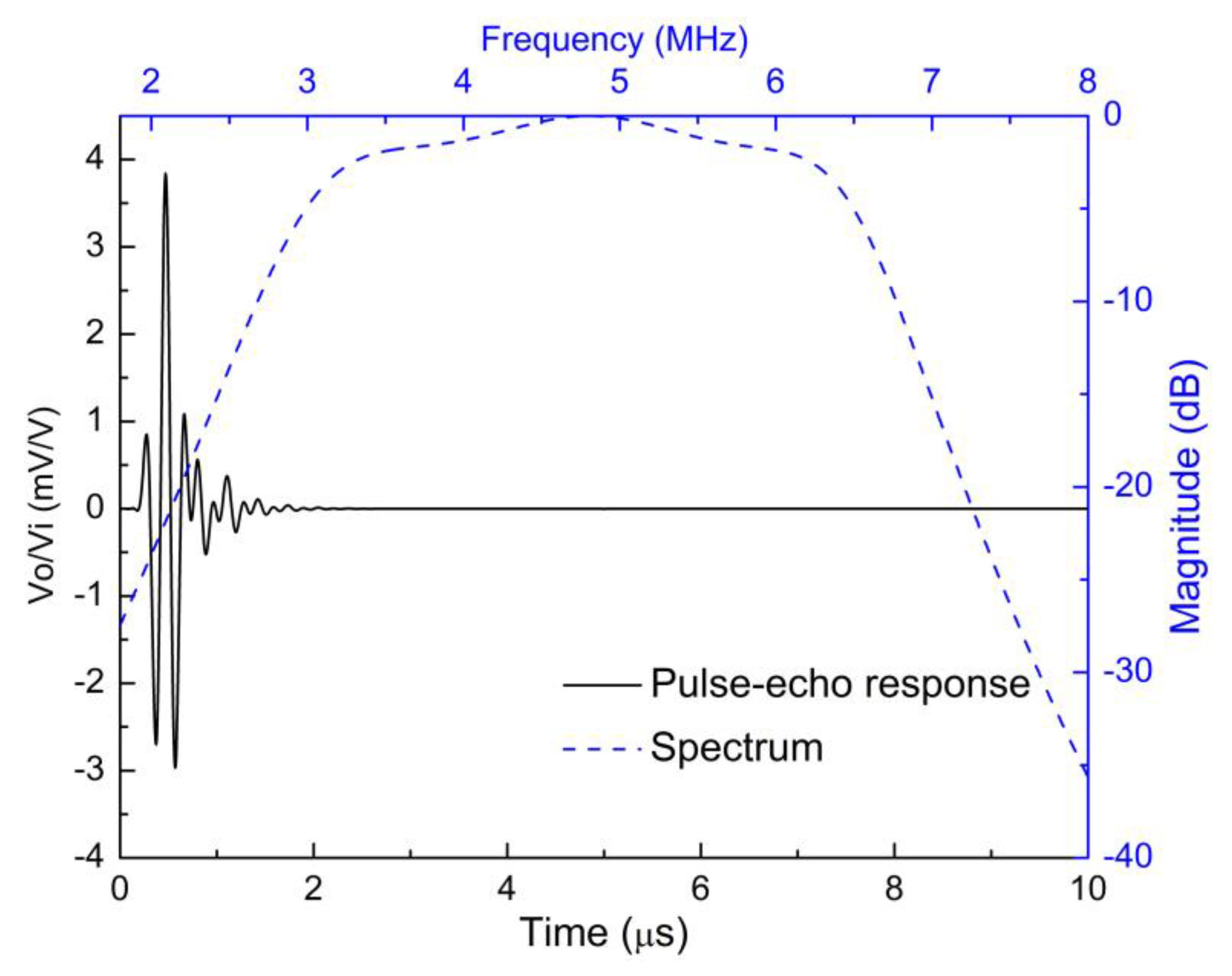

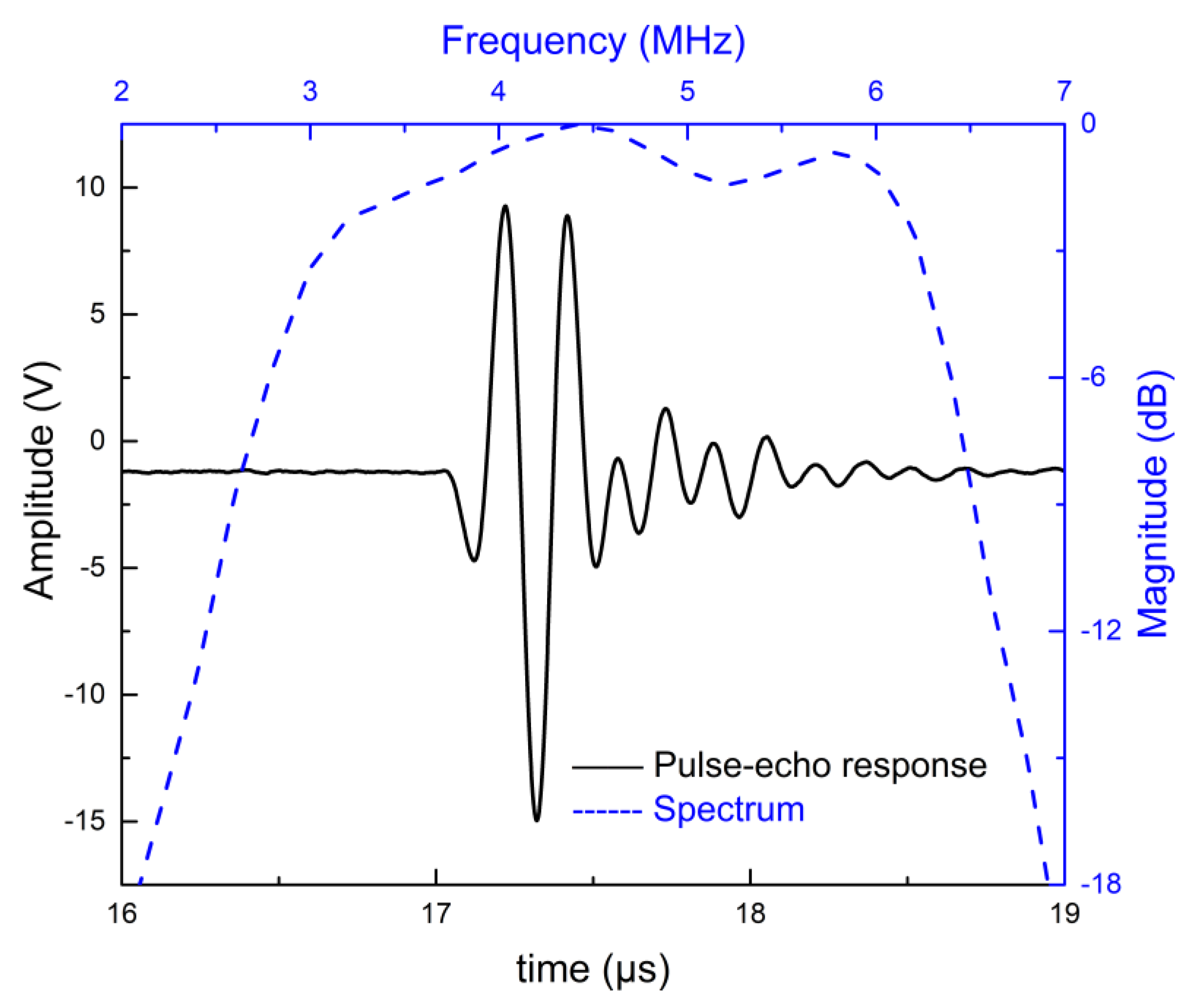
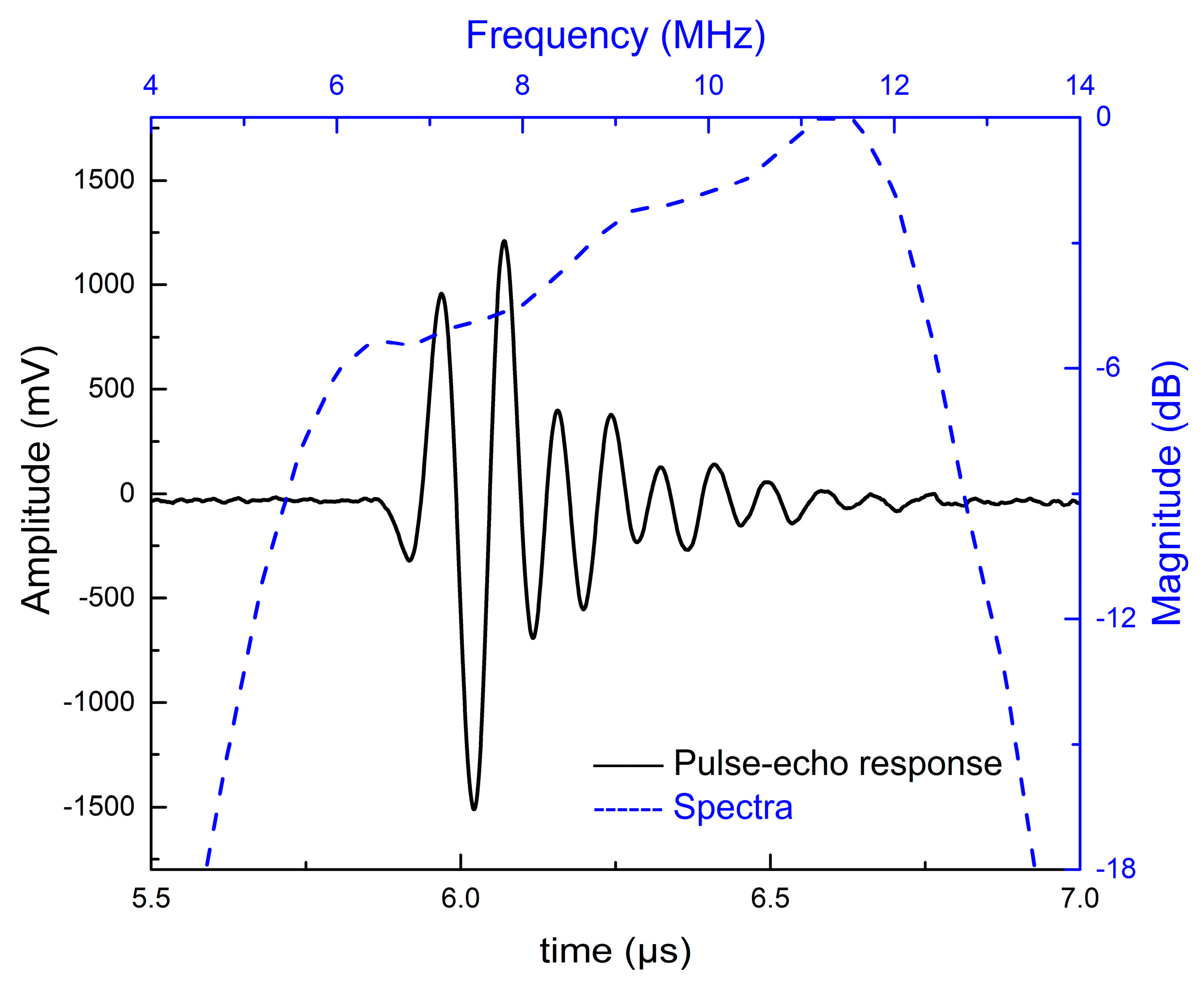
| PZT-5H | |
|---|---|
| Density, ρ | 7450 kg/m3 |
| Longitudinal velocity, v | 4560 m/s |
| Piezoelectric constant, d33 | 670 pC/N |
| Related clamped dielectric constant, εs/ε0 | 1802 |
| Frequency constant (thickness mode), | 1989 Hz·m |
| Electromechanical coupling coefficient, kt | 0.505 |
| Acoustic impedance, Za | 34.2 MRayl |
| Material 1 | Use | v (m/s) | ρ (kg/m3) | Za (MRayl) | Loss (dB/mm) |
|---|---|---|---|---|---|
| Tungsten/glass spheres/Epo-Tek 301 1 | Backing | 2256 | 4040 | 9.1 | N/A |
| Epo-Tek 301 | Matching layer 2 | 2650 | 1150 | 3.0 | 9.5 (at 30 MHz) [14] |
| AZ31B Magnesium alloy | Matching layer 1 | 5800 | 1780 | 10.3 | 0.02 (at 7.5 MHz) |
| Silver–epoxy composite 2 | Matching layer | 3860 | 1900 | 7.3 | 13.8 (at 30 MHz) |
| Alumina/polymer nanocomposite films 2 | Matching layer | 3200 | 1630 | 5.1 | 15 (at 40 MHz) |
| Property | 5 MHz Transducer | 10 MHz Transducer |
|---|---|---|
| Resonance frequency | 4.4 MHz | 8.81 MHz |
| Anti-resonance frequency | 4.87 MHz | 9.67 MHz |
| kt(eff.) | 0.43 | 0.41 |
| Active Element | Matching Materials | Backing Layers | fc (MHz) | BW (%) | IL (dB) |
|---|---|---|---|---|---|
| PZT-5H | AZ31B/Epo-Tek 301 | Tungsten powder/glass microspheres/Epo-Tek 301 | 4.60 | 79 | −11.11 |
| PZT-5H | AZ31B/Epo-Tek 301 | Tungsten powder/glass microspheres/Epo-Tek 301 | 9.25 | 71 | −14.43 |
| PZT-5A 1 | Anodic aluminum oxide-epoxy/Epo-Tek 301 | Tungsten powder/micro bubbles/Epo-Tek 301 | 11.6 | 68 | −22.7 |
| PZT-5A 1 | silicon–polymer 1–3 composite/Epo-Tek 301 | Tungsten powder/micro bubbles/Epo-Tek 301 | 15 | 50 | - |
| PZT 2 | 2-2 silicon–polymer composite/Spurr’s epoxy | Air | 14.6 | 70.2 | −18.4 |
© 2018 by the authors. Licensee MDPI, Basel, Switzerland. This article is an open access article distributed under the terms and conditions of the Creative Commons Attribution (CC BY) license (http://creativecommons.org/licenses/by/4.0/).
Share and Cite
Wang, Y.; Tao, J.; Guo, F.; Li, S.; Huang, X.; Dong, J.; Cao, W. Magnesium Alloy Matching Layer for High-Performance Transducer Applications. Sensors 2018, 18, 4424. https://doi.org/10.3390/s18124424
Wang Y, Tao J, Guo F, Li S, Huang X, Dong J, Cao W. Magnesium Alloy Matching Layer for High-Performance Transducer Applications. Sensors. 2018; 18(12):4424. https://doi.org/10.3390/s18124424
Chicago/Turabian StyleWang, Yulei, Jingya Tao, Feifei Guo, Shiyang Li, Xingyi Huang, Jie Dong, and Wenwu Cao. 2018. "Magnesium Alloy Matching Layer for High-Performance Transducer Applications" Sensors 18, no. 12: 4424. https://doi.org/10.3390/s18124424





